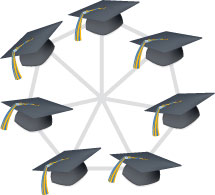Crowdsourcing in Your Classroom
How can you shift your classroom away from lecture and toward inquiry? You can get help from the modern phenomenon known as crowdsourcing—the practice of putting many minds to work on a single problem. Inquiry is, in effect, crowdsourcing in your classroom.
What Crowdsourcing Concepts Can Help Me?
The following four concepts from crowdsourcing can help you use more inquiry in your classroom.

-
Distributed Computing. While the term crowdsourcing is relatively new, the idea has been around for a while. One early example is the University of Berkley’s SETI project (Search for Extra-Terrestrial Intelligence), started in 1999, with over three million people devoting time on their personal computers to process radio signals. Other projects put crowds of human brains to work on even thornier problems. Just last September, over the course of three weeks, Fold.It gamers decoded an AIDS protein that scientists had been struggling with for 15 years. And inspired by the success of Fold.It, EyeWire.org recently launched a project asking people to help color-code neurons in the human retina.
Classroom Application
- A starting point for distributed computing in your classroom is to have students create their own unit overviews. Here’s how. Instead of lecturing to introduce a new unit, assign partners or groups to find out about specific topics in the unit. For example, to introduce a unit on the Civil War, you could list topics such as battles, generals, causes, public opinion, economics, technology, media, casualties, and so on. Then ask partners or groups to select a topic to investigate. Take the class to the library or media center for a half-hour inquiry into their topics. Afterward, have each group report briefly on what they discovered. This distributed-computing approach engages students and fosters research, collaboration, and presentation skills. It also covers the high points of the topic through crowdsourcing instead of lecture.
- A next step is to have students help develop the tools for assessing their work. Ask students what they want to accomplish—what excellent work would look like. Involve them in creating a rubric. This brainstorming process works even for young students, as is shown in this video about a bridge-building class. By involving students in creating the tools for their assessment, you get buy-in from them and often end up with a more rigorous assessment tool than you would otherwise have.
- When you and your students gain real comfort with distributed computing, you might have them participate in planning the semester’s syllabus. Have them brainstorm what makes a successful learning experience. Present the core standards on which they’ll be tested, and ask for project ideas to reach those goals. Gather student suggestions on the board and then guide a discussion analyzing how to implement them. By enlisting students in this part of their education, you show that they are responsible for their own learning. You also teach them the metacognitive skills they need to be lifelong learners.
-
Guerrilla Marketing. Before the Internet, advertising was all about jingles on the radio and billboards by the highway. Madison Avenue spent millions of dollars to push advertising toward consumers. Nowadays advertising is also about the pull of an idea—Twitter buzz and Facebook shares. Marketing is driven by consumers as much as by producers. You, too, can benefit from guerrilla marketing by harnessing the energy of students through inquiry. They will quickly become real proponents for change in the classroom.
Classroom Application
- Prime the pump by presenting your students with a few exciting examples of project-based learning, such as this amazing high school weather balloon project or this middle school earthquake project, or this elementary school worm project. You’ll find a whole gallery of fascinating projects at the High Tech High Web site.
- Ask your students what projects they have done in the past. Have them describe their experiences. Then ask what kinds of projects they would like to do in the future. Have them brainstorm an extensive list that you write on the board. You can then look for project ideas that align to the standards that you need to teach. When you assign a project to the class, students will realize it was one of their ideas, and they will feel ownership of their learning.
- At that point, your work is done. Your guerrilla marketers have been converted. Students will go out and tell others the cool things they are doing in your class. Soon enough, each new group of students you face will come to class expecting to take part in their own learning. That’s the power of guerrilla marketing.
-
Product Evangelism. Crowdsourcing is not chaos. Behind every successful socially driven project, there’s at least one “product evangelist” with a guiding hand. Whether we’re talking Linus Torvalds and the rise of open-source Linux code, or Coca-Cola’s successful Facebook page, someone behind the scenes decides what becomes canon. The product-evangelist role can help you reimagine your work in the classroom, shifting from the “sage on the stage” to the “guide on the side.”
Classroom Application
- As instructor, you are the product evangelist of your subject. You’re the one who best knows what direction the journey should take. In military terms, you’re the grand strategist. You set the goals, whether that be understanding the ways in which a molecule can bond or explaining the significance of a piece of literature. You aren’t giving up control. You’re exercising control in a new way.
- Meanwhile, your students become the tacticians. Proceeding through inquiry (which is the scientific method), students work purposefully to reach the goals that you have set. Along the way, you offer advice or information, guiding their efforts.
- Of course, this approach to teaching far precedes modern crowdsourcing. Two and a half millennia ago, Socrates used questions to guide his own students in their search for knowledge. Instead of lecturing, Socrates drew information out of his students and probed their logic, thereby exploring gigantic concepts such as justice and courage.

-
Professional Connections. You probably have been practicing elements of crowdsourcing throughout your career. Many educators say that their students are their greatest teachers, and that’s how it should be. And, of course, you have had teacher mentors and friends who have taught you the fine art of classroom instruction. All of these people are part of your Personal Learning Network (PLN). You’re already a lifelong learner using 21st century skills, so make sure your students witness the crowdsourcing that you do.
Classroom Application
- Model the role of a life-long learner. While encouraging students in their curiosity and questioning, share some of your own experiences, as well. Give examples of problems you have tackled and people who have helped. Discuss solutions you tried, times you failed, what you learned, and how you succeeded.
- Then learn from your students—and let them see you learning. That will make a profound impact. It shows that being a learner isn’t about weakness but strength. Practice listening more than speaking. Lecture is “push technology,” but inquiry is “pull technology.”
- Recognize that just as your colleagues are a precious resource to you, students are critical resources to each other. They have a mutual future at stake, and it is only fitting that they help one another to reach it.


Working the Crowd
Stepping from behind the desk or lectern may seem frightening, but it’s also exhilarating. It doesn’t mean giving up authority. Rather, it means exercising your authority in a new way—as the most knowledgeable learner in the classroom. Most importantly, you’ll be preparing students for the sort of cooperative problem solving that goes on in the working world after education—the world that you already know.


Comments
Post new comment